PERFORMANCE STUDY GUIDE
GRADES 6—12

PERFORMANCE STUDY GUIDE
GRADES 6—12

The Jay and Susie Gogue Performing Arts Center at Auburn University engages audiences across the university, the state of Alabama and beyond with curated arts experiences that inspire, enlighten and unite.
Our annual K–12 School Performance Series provides opportunities for schoolchildren to enjoy exclusive performances by some of the most talented and accomplished artists from around the world. Prior to each K-12 school performance, teachers receive a learning guide containing details about the performance, artist and company, supplemental information about the art form and its history, and grade-appropriate activities designed to spark conversation and exploration in the classroom.
To learn more about education and community engagement initiatives at the Gogue Center, visit goguecenter.auburn.edu/education.
provided by Jay and Susie Gogue Performing Arts Center at Auburn University
910 South College Street
Auburn, Alabama 36849
developed by Jazz at Lincoln Center
Advised by Geoffrey Ward
Prepared by Justin Poindexter
k–12 school performance series contact Andrea Jarmon, D.M.A.
Education Coordinator

telephone: 334.844.7371
email: gpac_education@auburn.edu
PERFORMANCE STUDY GUIDE
GRADES 6—12
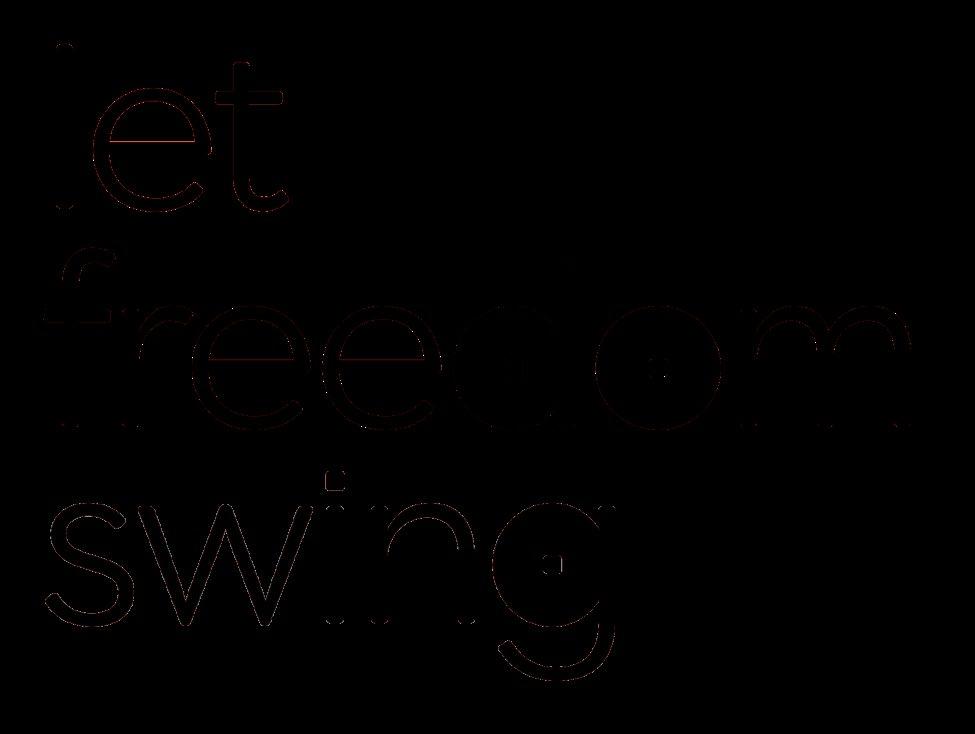
Let Freedom Swing brings outstanding jazz artists and performances to community audiences. Inspired by conversations between former U.S. Supreme Court Justice Sandra Day O’Connor and jazz musician Wynton Marsalis, Let Freedom Swing includes three jazz concerts: Jazz and Democracy, Jazz and the Great Migration and Jazz and Civil Rights.
The purpose of this guide is to provide educators with contextual information around the concerts. We have included big ideas around democracy and American history, jazz history and vocabulary, and key cultural figures. We have also included a list of audio, video and online resources that instructors may find useful in conjunction with the materials and suggested activities.
A PDF of the original resource guide additional resources may be found at jazz.org/letfreedomswing.
9–15
13–16
17–20
23–25
21–23
27–29
Let Freedom Swing is generously supported by Jody and John Arnhold, Jessica and Natan Bibliowicz, Stephen and Mary Beth Daniel, Diana and Joe DiMenna, Fred A. and Barbara M. Erb Family Foundation, Susan and J. Alan Khan, Sara Miller McCune, Rebecca and Daniel Okrent, Jacqueline L. Bradley and Clarence Otis, Jr., New York City Department of Cultural Affairs, The Price Family Foundation, Cheryl and Louis Raspino, The Rockefeller Foundation, Arthur and Rebecca Samberg, The Seedlings Foundation, and the Laurie M. Tisch Illumination Fund.
This Resource Guide was advised by Geoffrey Ward, prepared by Justin Poindexter, Assistant Director of Education and Community Programs, Jazz at Lincoln Center.
Photographs courtesy of the Frank Driggs collection, with the exception of pages 4, 5, 8, and 9 by Frank Stewart, and page 7, 14 and 18, Library of Congress, Prints & Photographs Division.
The original resource guide was advised by Geoffrey Ward and prepared by Justin Poindexter, assistant director of education and community programs, at Jazz at Lincoln Center.
Jazz can be played on any instrument, but here are brief descriptions of the most common instruments that make up a jazz ensemble and the roles they play.


The vocalist (top left) uses their voice as an instrument. Jazz vocalists can sing lyrics to songs as well as improvise solos just like a saxophone or trombone. Jazz vocalists can also scat-sing, a technique that uses nonsense syllables to improvise on the melody.
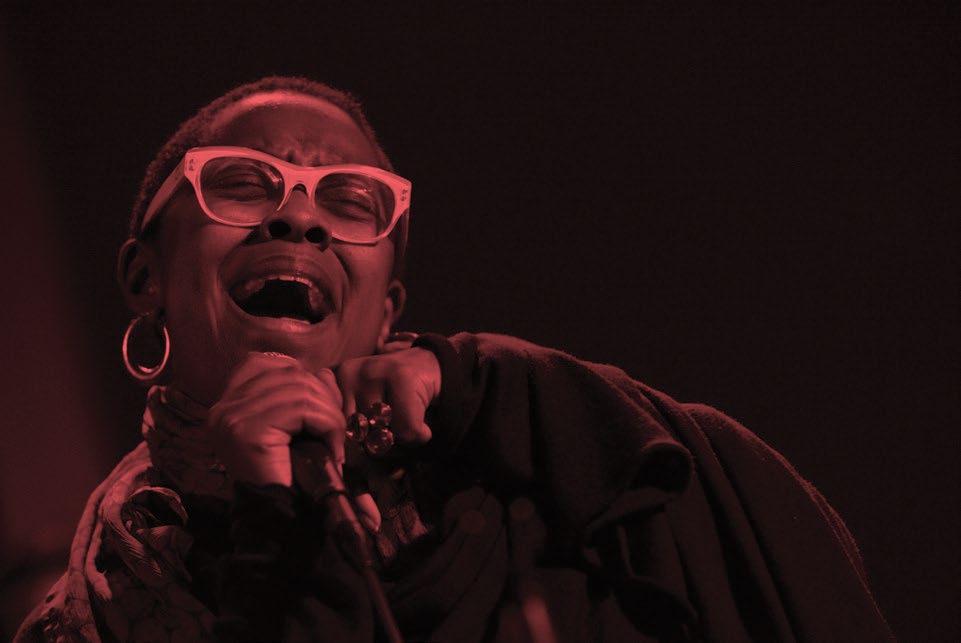
The trumpet (top right) is a member of the brass family. Made out of metal, brass instruments can create a range of colors and textures and are capable of making a very powerful sound. Trumpet players can play melodies and produce a range of sounds using mutes and vocal effects. They can shout, squeal, honk, growl, whisper and sing.
The trombone (bottom left) is also a member of the brass family. Lower in pitch than a trumpet, the trombone uses a slide to change notes. They can also play melodies and produce a range of sounds using mutes and vocal effects.
The saxophone (middle left) is a member of the woodwind family. Most woodwind instruments, with the exception of the clarinet, are also made of metal. Their warm tone (and their name) comes from the wooden reeds responsible for their sound.
The drums (top left) keep time for the band, creating and maintaining the groove with the bass player. The drummer can also interact with the rest of the band, “talking” to the other musicians by playing accents in response to the music.
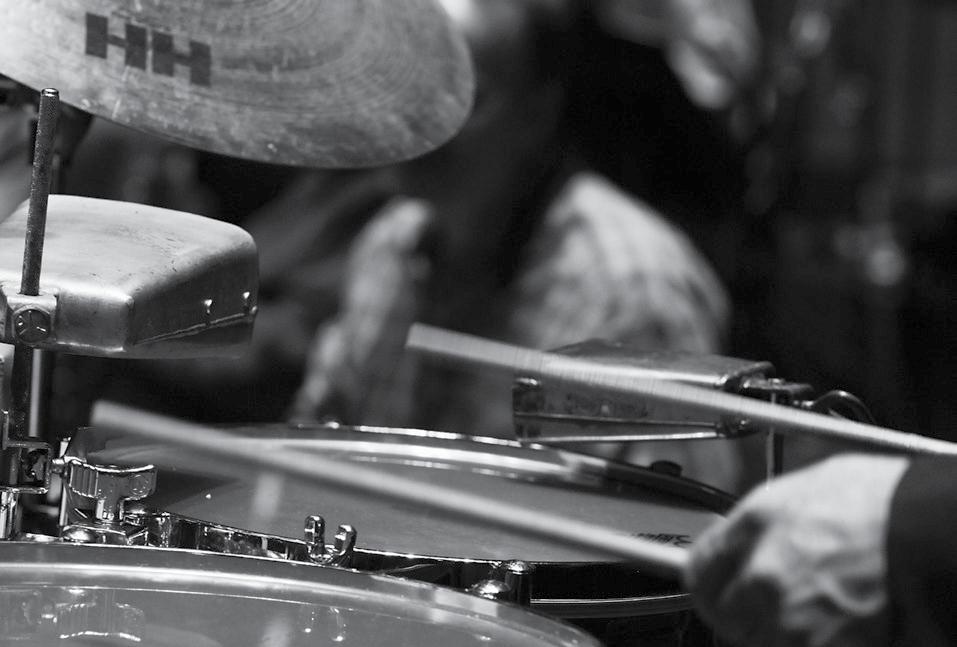
The bass (bottom right) player works very closely with the drummer to keep the groove together. They must listen closely to each other at all times, coordinating the rhythm of the bass with the swing pattern played on the ride cymbal. The bass player also outlines the harmonies of the music.

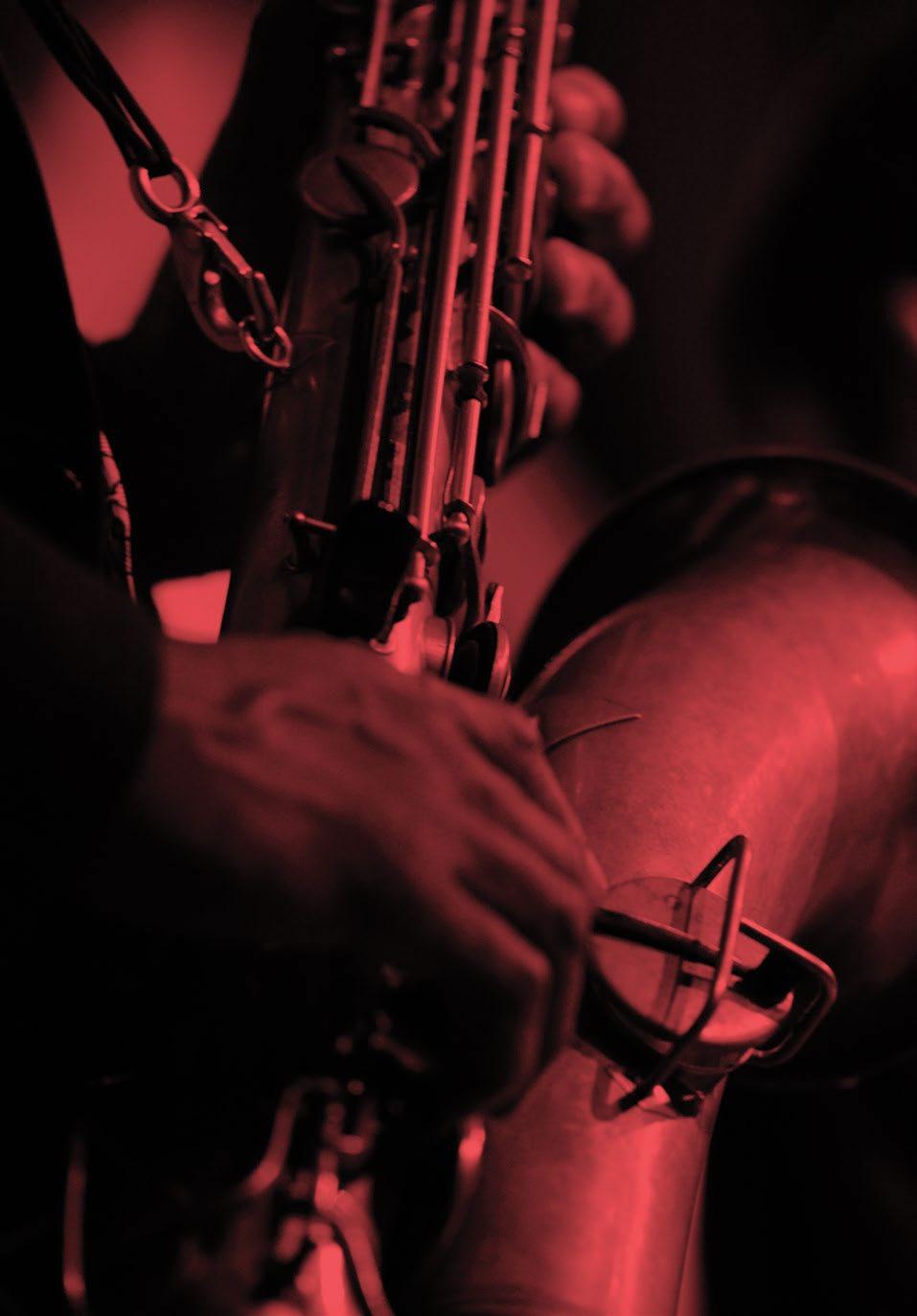
The pianist (top right) and guitarist (bottom left) support the harmonies and rhythms of the music. Unlike the bass player, who usually plays just one note at a time, pianists and guitarists can play many notes at once. They create rich combinations of notes (or chords) that support the melody and the soloist. Like the drums, they can also comment on the music with rhythmic accents.

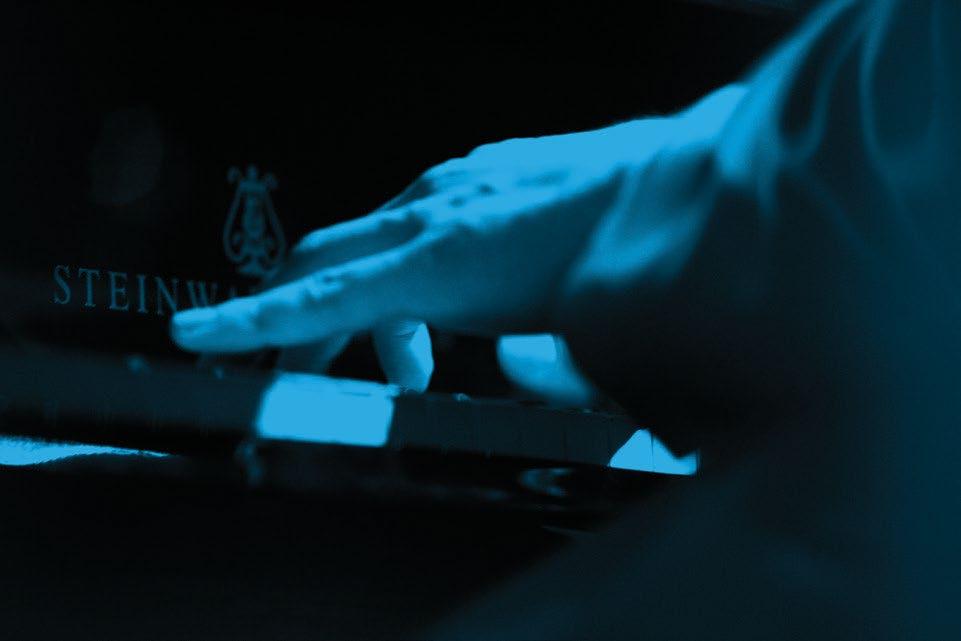
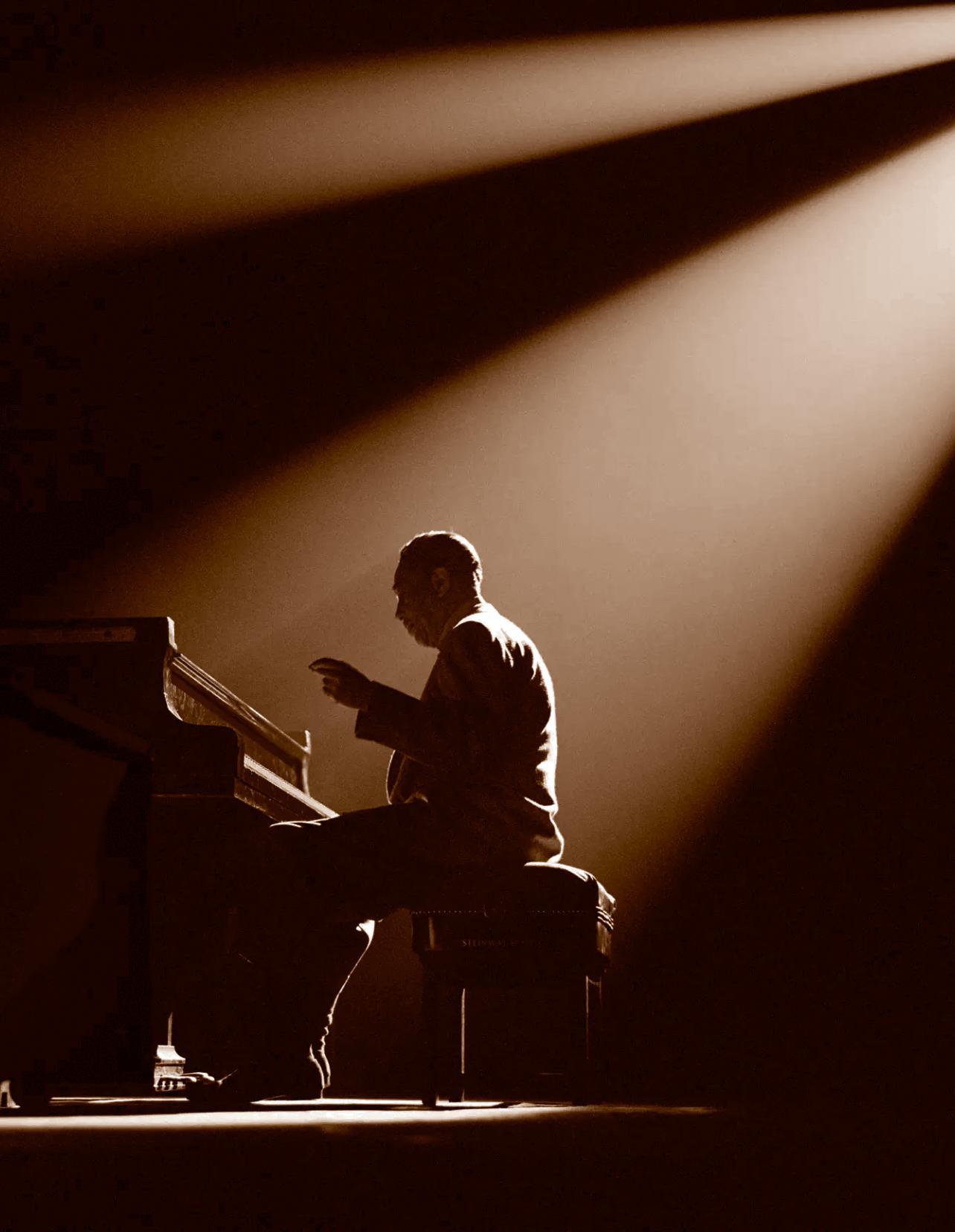 Edward Kennedy “Duke” Ellington (April 29, 1899–May 24, 1974)
Edward Kennedy “Duke” Ellington (April 29, 1899–May 24, 1974)
D E MOCRA CY • a system in which everyone can vote and share in making decisions
C I TIZEN • a member of a community, having rights, privileges as well as obligations
FR EEDO M • the right to do what you want, to make your own decisions, and express your own opinions
B LUES • an African American music developed in the South during the mid-1800s. It is the foundation of most American popular music. The blues is capable of expressing a wide range of emotions, often including sadness or loss.
I MPROVISATION • the act of making something up on the spur of the moment
S WING • the basic rhythmic attitude of jazz. When a whole band is swinging it means everyone is listening to and balancing with one another while still expressing their unique personalities. Swing also refers to a specific style of jazz for dancing featuring large ensembles.
Back O’ Town Blues— Louis Armstrong
Bourbon Street Parade— Louis Armstrong
Canal Street Blues— Louis Armstrong
Mahogany Hall Stomp— Louis Armstrong
New Orleans Function (Flee as the Bird /Didn’t He Ramble)— Louis Armstrong
Struttin’ With Some B arbecue— Louis Armstrong
St. James Infirmary— Louis Armstrong
Tiger Rag— Louis Armstrong
West End Blues— Louis Armstrong
When the Saints Go Marching In— Louis Armstrong
Every Day I Have the Blues— Count Basie featuring Joe Williams
Caravan— Duke Ellington
Creole Love Call— Duke Ellington
In a Mellow Tone— Duke Ellington
It Don’t Mean A Thing (If It Ain’t Got That Swing)— Duke Ellington
Things Ain’t What They Used To Be— Duke Ellington
Down by the Riverside— Mahalia Jackson
After You’ve Gone— Bessie Smith
Backwater Blues— Bessie Smith
Careless Love Blues— Bessie Smith
St. Louis Blues— Bessie Smith
supposed to be.”
WYNTON MARSALIS
“If the freedom of speech is taken away then dumb and silent we may be led, like sheep to the slaughter.”
GEORGE WASHINGTONTo listen to our Jazz and Democracy playlist on Spotify, visit aub.ie/jazz-democracy.
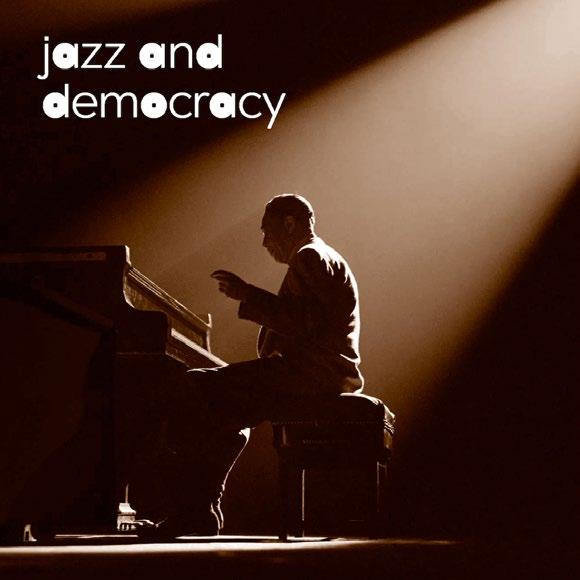

D E MOCRA CY • a system in which everyone can vote and share in making decisions
C I TIZEN • a member of a community, having rights, privileges as well as obligations
FR EEDO M • the right to do what you want, to make your own decisions, and express your own opinions
B LUES • an African American music developed in the South during the mid-1800s. It is the foundation of most American popular music. The blues is capable of expressing a wide range of emotions, often including sadness or loss.
I MPROVISATION • the act of making something up on the spur of the moment
S WING • the basic rhythmic attitude of jazz. When a whole band is swinging it means everyone is listening to and balancing with one another while still expressing their unique personalities. Swing also refers to a specific style of jazz for dancing featuring large ensembles.
American democracy was designed from the very beginning around the idea of personal freedom. These key phrases from early American history—“We the People ” E P luribus U num ” and a more perfect union” have served as important themes for our nation since its founding.
“We the People” are the first three words of the U.S. Constitution and highlight the truly revolutionary nature of the American historical enterprise in placing unprecedented faith in the ability of its citizens to establish a republic:
Back O’ Town Blues— Louis Armstrong
Bourbon Street Parade— Louis Armstrong
Canal Street Blues— Louis Armstrong
Mahogany Hall Stomp— Louis Armstrong
New Orleans Function (Flee as the Bird /Didn’t He Ramble)— Louis Armstrong
“We the People of the United States, in Order to form a more perfect Union, establish Justice, insure domestic Tranquility, provide for the common defense, promote the general Welfare, and secure the Blessings of Liberty to ourselves and our Posterity, do ordain and establish this Constitution for the United States of America.”
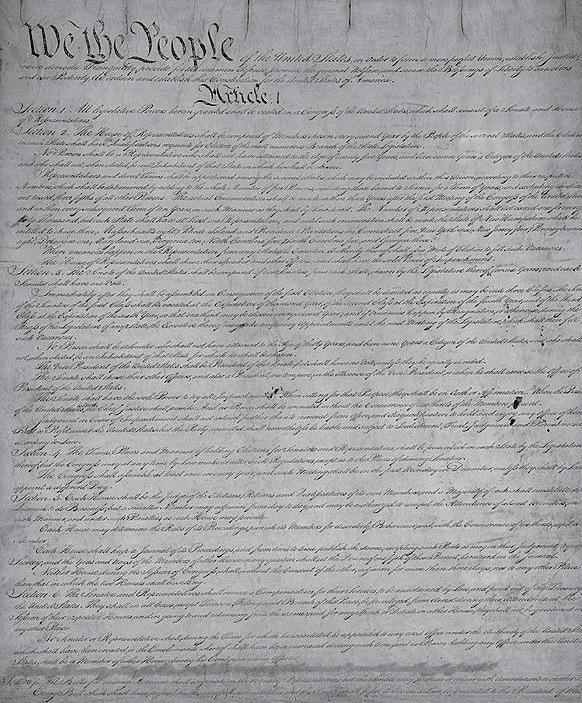
Struttin’ With Some B arbecue— Louis Armstrong
St. James Infirmary— Louis Armstrong
Tiger Rag— Louis Armstrong
West End Blues— Louis Armstrong
When the Saints Go Marching In— Louis Armstrong
“E P luribus U num ” (Latin for “out of many, one,”) was inscribed in 1776 on the face of the Seal of the United States. Long considered the official motto of the United States, “E P luribus U n um ” was as important in the 18th century as it is today in establishing an ideal for the nation—that many, different peoples could come together to form one society.
Every Day I Have the Blues— Count Basie featuring Joe Williams
Caravan— Duke Ellington
“Jazz calls us to engage with our national identity. It gives expression to the beauty of democracy and of personal freedom and of choosing to embrace the humanity of all types of people. It really is what American democracy is supposed to be.”
WYNTON MARSALIS
Creole Love Call— Duke Ellington
In a Mellow Tone— Duke Ellington
“A more perfect union” is a phrase that appears in the first section of the U.S. Constitution. This idea captures the aspirations of the early republic to continue to improve over time, a difficult and challenging project, both then and now.
It Don’t Mean A Thing (If It Ain’t Got That Swing)— Duke Ellington
Things Ain’t What They Used To Be— Duke Ellington
Down by the Riverside— Mahalia Jackson
After You’ve Gone— Bessie Smith
Backwater Blues— Bessie Smith
Careless Love Blues— Bessie Smith
These ideas are relevant to the world of jazz as well: a group of diverse musicians negotiating in time to create a collective expression that reflects the unique personalities and values of each individual for the good of everyone. The traditions of experimentation and improvisation in jazz resemble the innovative approach of America’s democracy in placing so much faith in its people and in striving to invent something new, different, and perhaps, even better.
St. Louis Blues— Bessie Smith
“If the freedom of speech is taken away then dumb and silent we may be led, like sheep to the slaughter.”
GEORGE WASHINGTON

Jazz grew out of the African American community in turn-of-the-20th-century New Orleans. It is a mingling of the musical expressions of all the people who came to the United States by choice or by force—people from Africa, Europe, Latin America and the Caribbean—as well as those already living in America. Jazz musicians brought their traditions together (with special emphasis on the blues, church spirituals and ragtime) in a new, universal language. Through the blues, jazz musicians showed that the sorrows common to us all could be overcome with optimism and humor. Through improvisation they celebrated newfound expressive freedom. And through the joyous rhythms of swing, they taught the many different people of New Orleans that they could work together with feeling and style.

Jazz spoke to all Americans and quickly spread upriver to St. Louis, Kansas City, Chicago, New York and beyond. In the 1920s new technologies like radio, the phonograph and talking motion pictures made it possible for millions to hear jazz across America and around the world. The propulsive rhythms of swing invited these new listeners to tell their stories too. As new generations of musicians filled the music with the depth of their personality, jazz evolved from small groups of early jazz to the brassy big bands of the swing era, the flashy virtuosity of bebop, to laid-back cool jazz, to fusion, free jazz and far beyond.
Jazz has since become a part of every American’s birthright, a timeless symbol of individualism and ingenuity, democracy and inclusiveness. At its very core, this music affirms our belief in community, in love, and in the dignity of human life. And if we let it, jazz can teach us—in ways beyond our imagination—exactly who we are, where we have been, and where we should be going.
“Jazz is the musical interplay of blues-based melodies, harmonies, rhythms and textures in the motion of an improvised groove.”
WYNTON M A RSALIS
A definition of jazz must include reference to the importance of the blues, swing and improvisation. These three ingredients plus melody, harmony, texture and rhythm are the fundamental elements of jazz. No one can deny that jazz is American music. Most people will also agree that jazz is a combination of the music of Europeans, Africans and other cultures.
The blues has many definitions; it is a type of music, a musical form, a harmonic language, an attitude towards playing music, a collection of sounds. Mostly though, the blues is a feeling; whether it’s happy, sad or somewhere in between, its intention is always the same: to make you feel better, not worse, to cheer you up, not bring you down. Playing the blues is like getting vaccinated. When you get a vaccination for small pox, for example, the doctor gives you small pox in a little dosage. Then your body produces the defenses to fight the disease. Similarly, if you want to get rid of the blues, you play the blues.
The blues was born out of the religious, work and social music of African Americans in the South during the late 1800s. It has since become the foundation of American popular music, including rhythm and blues, rock ‘n’ roll, country, and all periods and styles of jazz.

Swing is the basic rhythmic attitude of jazz. When a whole band is swinging it means everyone is listening to and balancing with one another. Similar to a working democracy, swing allows us to express our unique personalities while respecting each other in the context of a group.
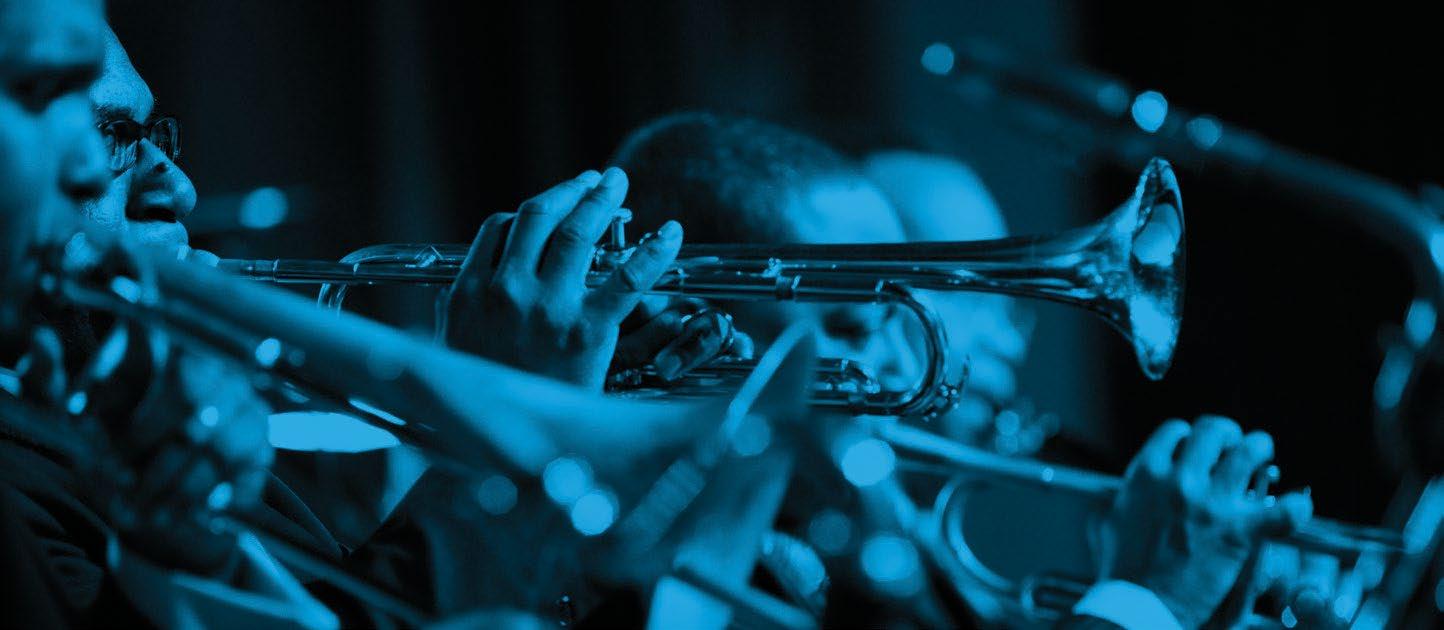
Swing is expressed as a rhythm with a tension between a top duple rhythm and a bottom triplet rhythm. The bottom rhythm is a steady 4/4—often called “four on the floor”—outlined by the walking bass. This four has extra emphasis on beats two and four (counted one–TWO–three–FOUR–one–TWO–three–FOUR, etc.). The top rhythm is a triplet 6/8 rhythm expressed by the drummer’s ride cymbal (counted one-two-three-four-five-six, one-twothree-four-five-six, etc.). The propulsive tension between these two rhythms, played together in balance, is the foundation of swing.
Swing also refers to a specific jazz style that evolved in the mid-1930s, a period of time known as the Swing Era. It is characterized by large ensembles that play complex arrangements meant for dancing.
Improvisation is the spontaneous creation of music. When a musician improvises, he or she invents music at the moment of performance, building on the existing theme and structure of the music. Jazz generally consists of a combination of composed, arranged and improvised elements, though the proportions of one to the other may vary. During a jazz performance, the ensemble plays a chorus or succession of choruses during which an individual player has the opportunity to improvise a solo.
In collective improvisation, two or more members of a group improvise at the same time Improvisation, both collective and solo, builds a relationship between the members of the ensemble, helping them to “talk” to one another and express their personalities. In other words, improvisation is what makes jazz the music of freedom.
Trumpet player and singer LOUIS ARMSTRONG is considered the most important improviser in jazz. With his infectious, wide grin and instantly recognizable gravelly voice, he won the hearts of people everywhere.
“My whole life has been happiness,” Armstrong liked to say, and for more than half a century he managed to make everyone who heard him feel that no matter how bad things got, everything was bound to turn out all right, after all. But his warm, unaffected presence sometimes masked the fact that he was the preeminent American musical revolutionary of his century.
Armstrong grew up in a poor family in a rough section of New Orleans. He started working at a very young age to support his family, singing on street corners for pennies, working on a junk wagon, cleaning graves for tips, and selling coal. His travels around the city introduced him to all kinds of music, from the blues played in the Storyville honky tonks to the brass bands accompanying the New Orleans parades and funerals. The music that surrounded him was a great source of inspiration. He received his first formal music instruction in the Colored Waif’s Home for Boys, where he was confined for a year and a half as punishment for firing a pistol into the air on New Year’s Eve.
As the young Armstrong began to perform with pick-up bands in small clubs and play funerals and parades around New Orleans, he captured the attention and respect of some of older established musicians. Joe “King” Oliver, one of the finest trumpet players around, became Armstrong’s mentor. In 1922, Oliver invited Armstrong to Chicago to play second cornet in his Creole Jazz Band. As a member of Oliver’s band, Armstrong began his lifetime of touring and recording. In 1924, he moved on to New York City to play with the Fletcher Henderson Orchestra at the Roseland Ballroom. The power and virtuosity of his playing on his own “Hot Five” and “Hot Seven” recordings made between 1925 and 1929 demonstrated that jazz could be a soloist’s art. Along the way he extended the range of his instrument, fused the sound of the blues with the American popular song, brought to American singing the same irresistible drive he’d brought to instrumental jazz, and became the beloved ambassador of America’s music throughout the world. Armstrong’s innovations influenced every instrumentalist and every singer who followed him. He was, as the trumpet player Max Kaminsky wrote, “the heir of all that had gone before and the father of all that was to come.”
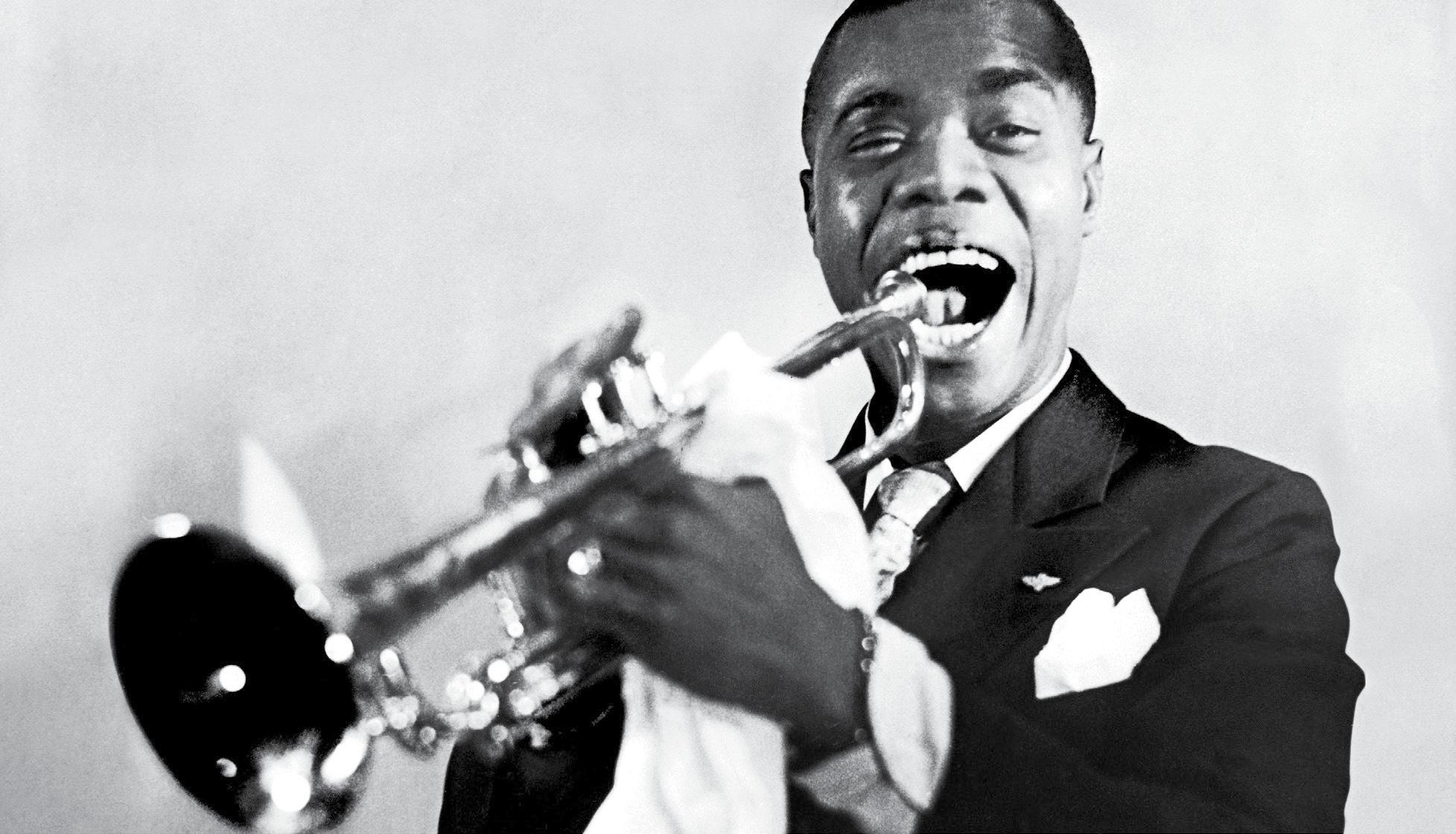
“If jazz means anything,” DUKE ELLINGTON once said, “it is freedom of expression.” No one in the history of jazz expressed himself more freely—or with more variety or swing or sophistication. He was a masterful pianist but his real instrument was the orchestra he led for half a century. More consistently than anyone else in jazz history, Ellington showed how great music could simultaneously be shaped by the composer and created on the spot by the players. Each of his almost 2,000 compositions—love songs and dance tunes, ballet and film scores, musical portraits and tone poems, orchestral suites and choral works and more—was crafted to bring out the best in one or another of the extraordinary individuals who traveled the road with him. Ellington hated what he called “categories,” and refused to conform to anyone else’s notion of what he should be doing. As a result he managed to encompass in his music not only what he once called “Negro feeling put to rhythm and tune” but the rhythm and feeling of his whole country and much of the wider world, as well.

“ BESSIE SMITH was a fabulous deal to watch,” the banjoist Danny Barker remembered. “She was a large pretty woman and she dominated the stage. You didn’t turn your head when she went on. You just watched Bessie.” Her stage presence may have mesmerized audiences but it was her huge, confident voice, captured on records and capable of conveying every human emotion from grief to joy without a hint of sentimentality or self-pity, that made her the acknowledged Empress of the Blues. She began her show business career in 1912 as a chorus girl with a touring tent show, Ma Rainey’s Rabbits Foot Minstrels. She was not the first singer to record the blues. That honor went to Mamie Smith (no relation) who set off the blues craze in 1920. But from the time she began to record in 1923, Bessie Smith out-sang and out-sold all her rivals. Great musicians accompanied her—Louis Armstrong, Sidney Bechet, James P. Johnson and more—but she was always the star, traveling in her own private railroad car, drawing huge crowds wherever African Americans lived, north as well as south, and admired by growing numbers of whites, as well.
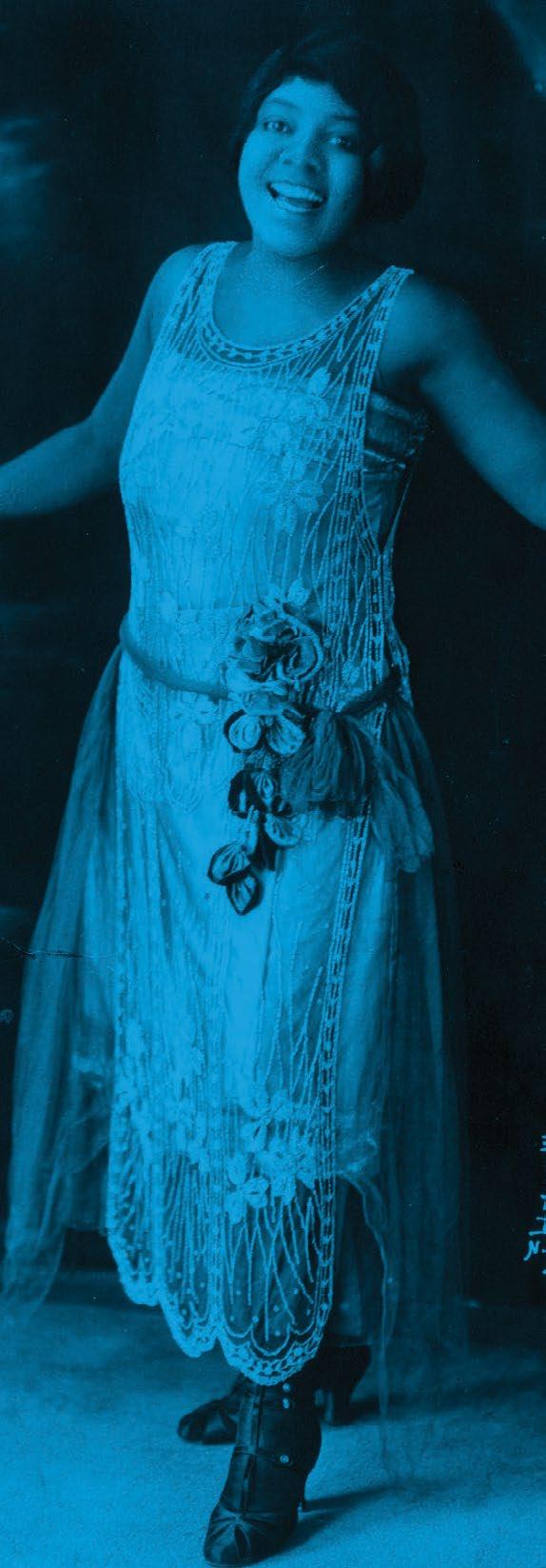
GOALS • Students learn about the process of improvisation through a familiar song. Students examine the concept of form and explore ways to change melody and rhythm while observing structure. Students also explore the group dynamics of an improvising jazz band.
STUDENT DISCUSSION • To reinforce the concept of form and improvisation, ask students to write down their class schedule for the entire week. Explain that this schedule is like a song form in that it is a set pattern. Then brainstorm as a class about what might happen in a week that could change a schedule. Also discuss what might happen each day within a class period, such as a different lunch, or sitting in a different seat that would allow them to change or improvise on their pattern.
After discussion, have each student take their schedule and improvise two more variations (or choruses) for their weekly schedules.
Write the lyrics of a familiar song such as "Happy Birthday" on the blackboard. Review the basic melody and rhythm of the song. Then, in groups, have students create their own improvised version of the song vocally or with instruments. Each group might designate one or two students the role of timekeeper/rhythm section. Students might also consider devices like call and response and riffs (short, repeated phrases) in their arrangement, as well as the various vocal inflections.
There’s a Latin saying on the U.S. dollar bill, E P luribus U num It means "out of many, one," and it epitomizes the democratic process of a jazz band. In order to swing, jazz musicians work together for the greater good of the music. They have to balance their own desire to lead and express themselves with those of the rest of the band. Sometimes one soloist will lead while the band follows, then those roles may switch. Other times, a musician will just hang out and wait for the music to welcome them back. In this activity, students will experience leading and following through movement and then on their instruments.
1. Everyone find a partner.
1 Everyone find a partner.
2 Face each other, hands open in front, hands barely touching.
“The vocabulary of jazz, the basic building blocks of the music, are metaphors for communication. These haven’t changed very much since the very early days. Call and response means, I speak and you answer. A break…I stop and let you talk or vice versa. Solos…we each get a chance to expound on the subject. Riffs…we agree. Improvisation…what we say and how we say it. And finally, swing, which means coordinating all this communicating with style and good manners.”
WYNTON MARSALIS2. Face each other, hands open in front, hands barely touching.
3 Decide who will be the leader and who will be the follower.
4 Let the leader take your hands wherever they lead you. Again your hands are not touching.
3. Decide who will be the leader and who will be the follower.
5 Now switch roles.
4. Let the leader take your hands wherever they lead you. Again your hands are not touching.
6 Next just hang, if you feel like leading, lead or just follow let it flow. trust
7 Reflect: Did you prefer leading, following, or just hanging out?
5. Now switch roles.
8 Still in pairs, give each student an Orff or percussion instrument. Set up the 2 instruments so that students can play them while facing each other.
9 Demonstrate and practice a swing rhythm using instruments.
6. Next, just hang. If you feel like leading, lead, or just follow—let it flow. Trust.
10 Decide who will be the leader and who will be the timekeeper, playing a swing pattern.
11 Play, wordlessly allowing the leadership and timekeeper roles to change over time.
7. Reflect: Did you prefer leading, following, or just hanging out?
12 Reflect: How did students know when to change roles? What musical characteristics emerged over the course of the performance (ex: call and response, dynamics, tempo, registers, textures etc.)?
8. Still in pairs, give each student an Orff or percussion instrument. Set up the two instruments so that students can play them while facing each other.
9. Demonstrate and practice a swing rhythm using instruments.
10. Decide who will be the leader and who will be the timekeeper, playing a swing pattern.
11. Play, wordlessly allowing the leadership and timekeeper roles to change over time.
12. Reflect: How did students know when to change roles? What musical characteristics emerged over the course of the performance (e.g., call and response, dynamics, tempo, registers, textures, etc.)?
Ella Fitzgerald (April 25, 1917–June 15, 1996)


RENA ISSANCE • a movement or period of great activity (as in literature, science, and the arts)
C O MMU NITY • an interacting population of various kinds of people in a common location
CULTURE • the way of life, especially the customs and beliefs of a particular group of people
S ELF- EX P RES SION • the expression of your thoughts or feelings especially through artistic activities (such as painting, writing, dancing, etc.)
C ALL AND RESPONSE • a musical conversation in which instrumentalists and/or vocalists answer one another

RE NT PARTY • a party where tenants hire a musician or band to raise money to pay their rent
STR IDE PIANO • a style of playing piano in which the left hand covers wide distances, playing bass harmony and rhythm at the same time, while the right hand plays melodies and intricate improvisations
Dinah— Louis Armstrong
On the Sunny Side of the Street— Louis Armstrong
Shine— Louis Armstrong
Up a Lazy River— Louis Armstrong
Royal G arden Blues— Bix Beiderbecke
Black and Tan Fantasy— Duke Ellington
East St. Louis Toodle-Oo— Duke Ellington
Harlem Airshaft— Duke Ellington
Take the A Train— Duke Ellington
A Fine Romance— Ella Fitzgerald a nd Louis Armstrong
Blue Skies— Ella Fitzgerald
How High the Moon— Ella Fitzgerald
Lady Be Good— Ella Fitzgerald
Stompin’ at the Savoy— Ella Fitzgerald a nd Louis Armstrong
They Can’t Take That Away From Me— Ella Fitzgerald a nd Louis Armstrong
Summertime— Billie Holiday
It’s Tight Like That— McKinney’s Cotton Pickers
Dippermouth Blues— King Oliver
The Joint is Jumpin’— Fats Waller
Ain’t Misbehavin’— Fats Waller
Honeysuckle Rose— Fats Waller
To listen to our Jazz and the Great Migration playlist on Spotify, visit aub.ie/great-migration.
The largest human migration in American history began in 1915. Over the next half-century, nearly six million African Americans packed their belongings, left their homes in the Jim Crow South, and set out for the big cities of the North in search of jobs and freedom. Known as the “Great Migration,” the poet Alain Locke wrote, this mass movement was “a deliberate flight not only from countryside to city, but from medieval America to modern.”
City life in the North was immeasurably enriched by the arrival of so many strangers from the South. But American culture was transformed forever because jazz was part of the newcomers’ baggage. Wherever they settled it found eager new audiences. New York’s Harlem, Chicago’s South Side, the wide-open streets of Kansas City, Missouri, the Paradise Valley neighborhood in Detroit, Central Avenue in Los Angeles, and many other new jazz-rich big-city enclaves all across the country became proving grounds for America’s music.
Each city was important to the music’s development, and each added its own unique flavor to the mix. Still, as Duke Ellington remembered, ”Harlem in our minds had the world’s most glamorous atmosphere. We had to go there.” Ellington moved from Washington, D.C. to Harlem in 1923. Other eager young musicians flocked there, too. Harlem was then the cultural capital of Black America, home to the Harlem Renaissance, a remarkable coalescing of African American artists, that included activists W. E.B. DuBois and Marcus Garvey, and the writers James Weldon Johnson Langston Hughes and Zora Neale Huston.

All kinds of jazz flourished in its cabarets and nightclubs and dance halls but in the 1920s, one solo piano style seemed especially well suited to the city’s fast-paced, competitive spirit. Harlem stride or “eastern ragtime” is “orchestral piano,” one practitioner said: While the left hand “strides,” establishing a steady rhythm by alternating between bass notes at the end of the keyboard and chords around its middle, the right hand is free to play swinging, intricate melodies as if it were a horn.
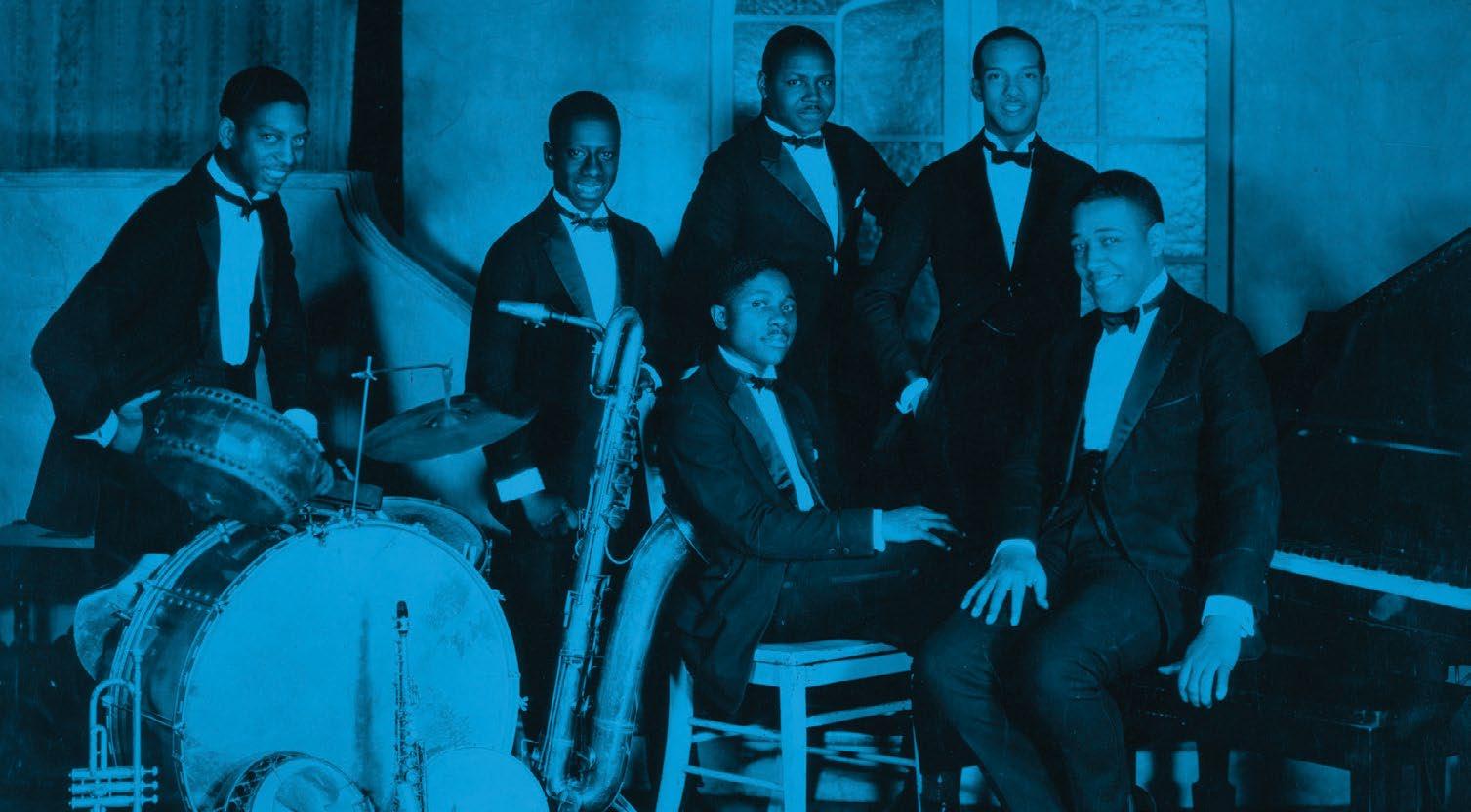
Two stride-masters stood out above the rest: James P. Johnson and his friendly rival, Willie “The Lion” Smith. “Sometimes we got carving battles going that would last four or five hours,” The Lion remembered. Rent parties were their specialty—all-night dances held in crowded apartments where the price of admission helped keep the landlord at bay. “They would crowd a hundred people … into a seven-room railroad flat,” The Lion recalled, “and the walls would bulge—some of the parties spread to the halls and all over the building.” He and Johnson usually fought to a draw, Duke Ellington remembered. “It was never to the blood. With those two guys it was always a sporting event. Neither cut the other. They had too much respect for that.”

DUKE ELLINGTON was born in Washington, D.C. on April 29, 1899. His parents both played piano and they encouraged their son to study music at a very early age. In 1923, Ellington moved to New York, where he joined the cultural revolution known as the Harlem Renaissance. Composer Will Marion Cook advised young Ellington, “First…find the logical way, and when you find it, avoid it and let your inner self break through and guide you. Don’t try to be anybody else but yourself.” It was a lesson Ellington would carry throughout his career.
Ellington and his group, The Washingtonians, found a steady job at the Kentucky Club near Times Square. Though he was just beginning his career as a composer, his five-piece band quickly earned attention for its fresh and unusual sound, highlighted by the startling growls of trumpeter Bubber Miley. Their growing reputation eventually earned the band a job at Harlem’s prestigious Cotton Club, where they would stay from 1927 to 1931. The band, a musical laboratory of sorts, continued to expand in size, offering its leader ever-varied tone colors with which to experiment. Armed with a growing arsenal of sounds and textures, Ellington began to broaden the scope of his work, experimenting with extended song forms, unconventional harmonies, and orchestrations. Over the next five decades, Ellington embraced the scope of American music like no one else. He synthesized ragtime, the minstrel song, Tin Pan Alley, the blues, and American appropriations of the European music tradition, creating a consistent and recognizable style.
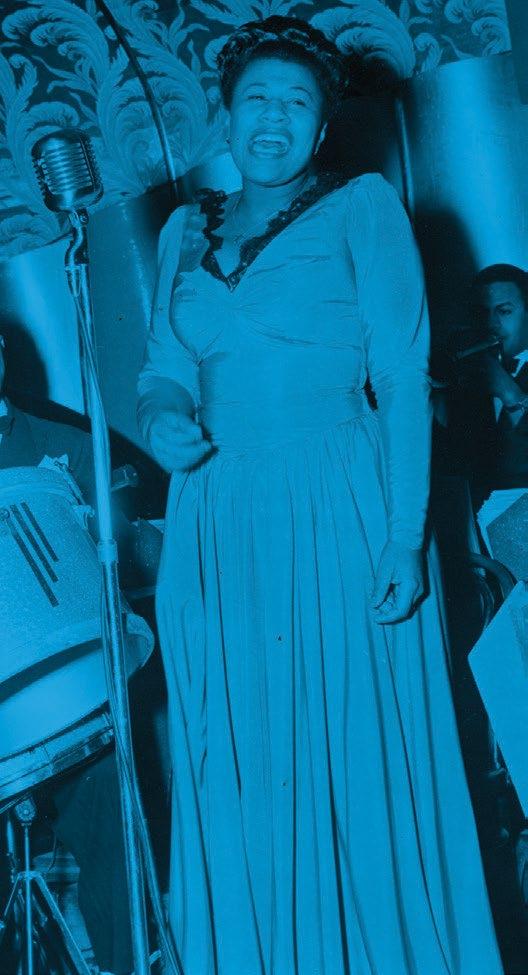
THOMAS “FATS” WALLER had such a magnetic personality and was such a consummate showman, one younger musician remembered, that “you could never be sad in his presence.” Waller’s bubbling stage persona —leering and lampooning the tunes he sang and played, shouting to urge his men on—often hid the master he really was. After Duke Ellington, Waller was the most prolific and successful songwriter to emerge from the world of jazz. Songs like “Ain’t Misbehavin’,” “Honeysuckle Rose” and “Keepin’ Out of Mischief Now” (all written with lyricist Andy Razaf) became American standards and helped make him nearly as celebrated in his lifetime as his friend Louis Armstrong. He was also the first jazz musician to record on the organ, but his most lasting impact was as a pianist. Building upon the Harlem stride he learned from his mentor, James P. Johnson, Waller developed his own irresistibly swinging style. His tireless left hand set the driving pace while his right served up delicate figures that continue to dazzle pianists. Jimmy Rowles marveled that Waller seemed able to “think in two directions.” “Fats,” said Art Tatum, “that’s where I come from.” And Mary Lou Williams urged students hoping to learn how to play jazz to “go back to Fats Waller. That’s the metronome.”
“If the musicians like what I do,” ELLA FITZGERALD once said, “then I feel I’m really singing.” She was a child of the Great Migration, born in Virginia but brought north to Yonkers, New York as a little girl. Discovered at 16 after winning an amateur night contest at the Apollo Theater in Harlem, she first won fame in the late 1930s, performing novelty tunes and romantic ballads with the hard-swinging Chick Webb Orchestra. During the 1940s, she recorded with every kind of backup group and established herself as a master of scat singing, incorporating the fresh harmonies and rhythms of bebop into wordless acrobatic performances that astonished audiences and musicians alike. Her gift of swing, impressive scatting, precise diction and extraordinary range made her as adept a soloist as any horn player. Then, in the 1950s, she recorded definitive versions of standards by America’s greatest songwriters, from Cole Porter to Duke Ellington. Through it all, she never lost the girlish joy evident on her earliest records, never seemed to sing out of tune, and never failed to swing. Musicians were awed by her musicianship. For her, “music is everything,” her sometime accompanist Jimmy Rowles said. “When she walks down the street, she trails notes.”
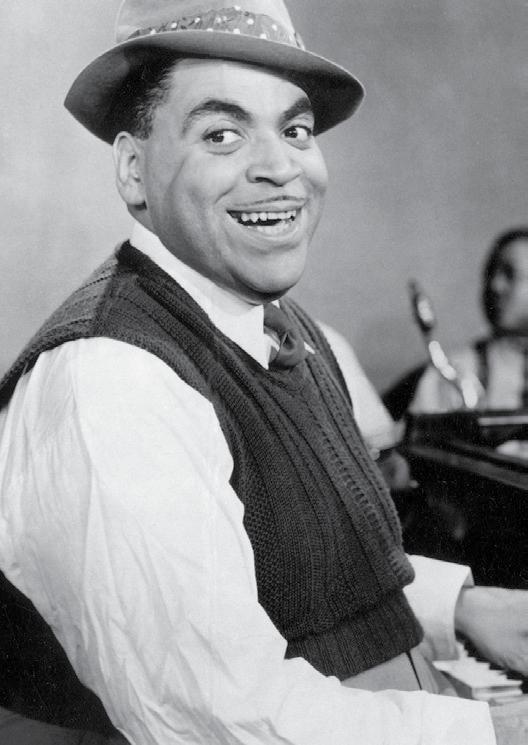
GOALS • Students unleash their imagination and explore the emotional power and lasting influence of the blues. Students will also create their own blues-inspired pieces in groups.
1 Through interactive questions and answers, discuss the idea of universal human emotions, and how music, a universal language, has traditionally been used to express and share these feelings.
1. Through interactive questions and answers, discuss the idea of universal human emotions, and how music, a universal language, has traditionally been used to express and share these feelings.
2 Have students imagine, and/or write about an experience that caused them sadness or pain.
2. Have students imagine, and/or write about an experience that caused them sadness or pain.
3. Form a circle and one at a time, have each student make a vocal sound that represents the feeling of the sad or painful emotion. Have the rest of the class repeat the sound together.
3 Form a circle and one at a time, have each student make a vocal sound that represents the feeling of the sad or painful emotion. Have the rest of the class repeat the sound together.
“It’s important to understand the difference between having the blues and playing the blues. Having the blues is sad. But playing the blues is like taking medicine. Actually it’s like being vaccinated. If you get a vaccination for small pox, for example, the doctor actually gives you small pox in a little dosage. And then your body produces the defenses to fight the disease. That’s what the blues is. If you want to get rid of the blues, you play the blues.”
4. Divide the group in half, one half clapping on beats two and four. The other half will experiment “riffing” their blues sounds with the beat.
4 Divide the group in half, one half clapping on beats two and four. The other half will experiment “riffing” their blues sounds with the beat.
WYNTON MARSALIS, Jazz for Young People Curriculum5. Divide into teams of four or five and have each group create a short piece using their original sounds, integrating the swing rhythm, call and response, improvisation, and class percussion instruments, if possible.
5 Divide into teams of four or five and have each group create a short piece using their original sounds, integrating the swing rhythm, call and response, improvisation, and class percussion instruments, if possible.
6 Perform the blues-inspired pieces for one another. Discuss if and how expressing and sharing feelings through sound and music can transform a feeling of pain or sadness into one of joy and humor.
6. Perform the blues-inspired pieces for one another. Discuss if and how expressing and sharing feelings through sound and music can transform a feeling of pain or sadness into one of joy and humor.
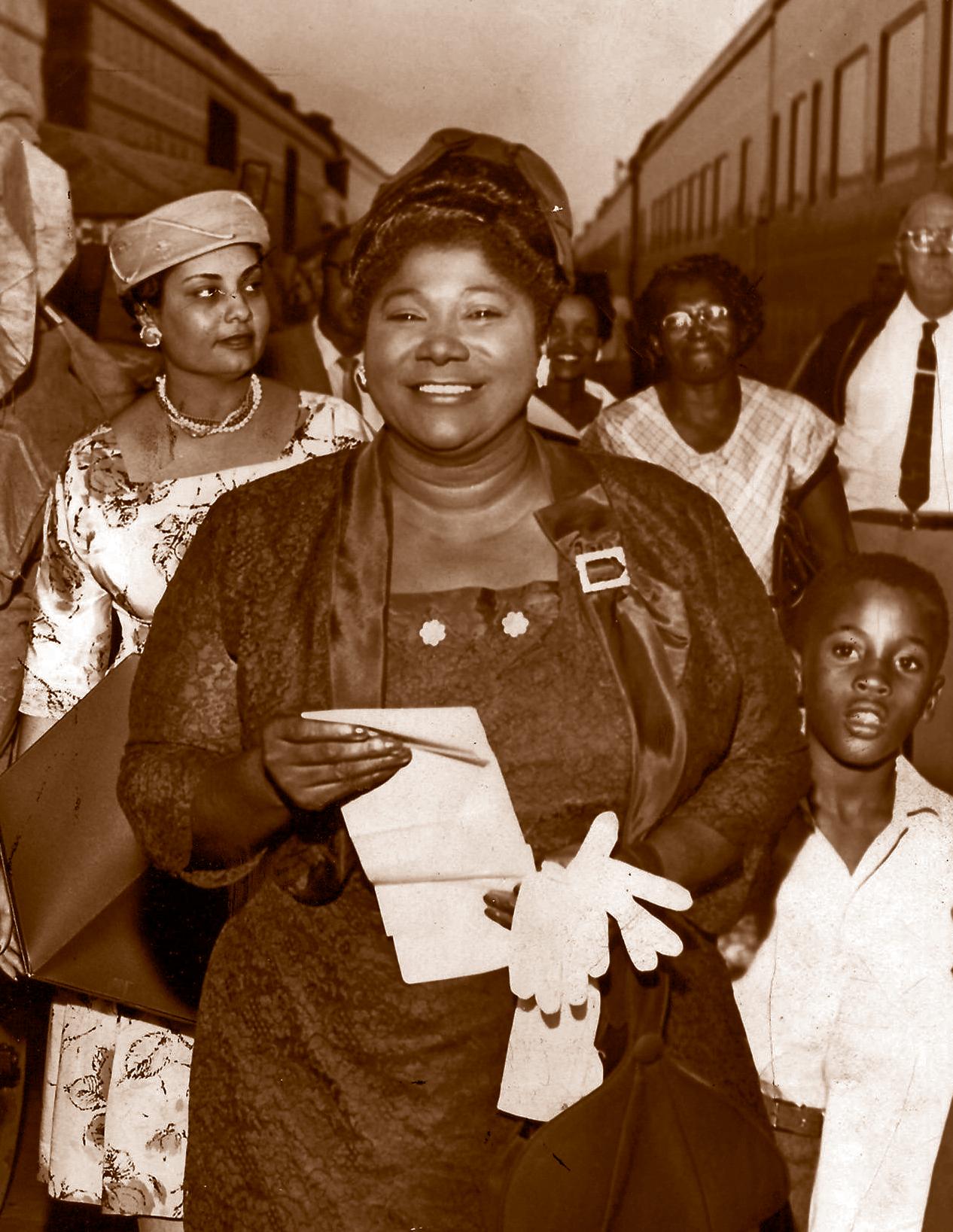 1. Mahalia Jackson (October 26, 1911–January 27, 1972)
1. Mahalia Jackson (October 26, 1911–January 27, 1972)
Born October 18, 1961
 Wynton Marsalis
Wynton Marsalis
FR EEDO M • the right to do what you want, to make your own decisions, and express your own opinions
PROTEST • a statement or action expressing disapproval of or objection to something; also an organized public demonstration expressing strong objection to a policy or course of action
SEGREGATION • the action of setting someone or something apart from others; also, in U S history, the enforced separation of different racial groups
F REE JAZZ • a style of music pioneered by Ornette Coleman in the late 1950s that abandoned Western harmony and rhythm in favor of greater freedom of self expression
LYRIC S • the words of a song
SPIRITUAL • a type of religious song developed by African Americans
Mercy, Mercy, Mercy— Cannonball Adderley
Work Song—C annonball Adderley / Nina Simone
(What Did I Do To Be So) Black and Blue— Louis Armstrong
I’ve Known Rivers— Ga ry B artz
Moanin’— Art Blakey and the Jazz Messengers
Travelin’ Blues— Dave Brubeck
Lonely Woman— Ornette Coleman
Alabama—John Coltrane
A Love Supreme—John Coltrane
Freedom Jazz Dance— Miles D avis
Strange Fruit— Billie Holiday
Freedom Is In the Trying—Wynton Marsalis
Compared to What— Les McCann and Eddie Harris
Fables of Faubus— Charles Mi ngus
Freedom— Charles Mi ngus
Moanin’— Charles Mi ngus
Wednesday Night Prayer Meeting— Charles Mi ngus
Freedom Day— Max Roach and Abbey Lincoln
I Wish I Knew How it Would Feel to be Free— Nina Simone
Mississippi G oddam— Nina Si mone
Lift Ev’ry Voice and Sing
Swing Low Sweet Chariot
This Little Light of Mine
Wade in the Water
We Shall Overcome
To listen to our Jazz and Civil Rights playlist on Spotify, visit aub.ie/civil-rights.


“Jazz,” Duke Ellington once said is a “barometer of democracy.“ All through the years jazz has exemplified all that is most admirable about the country that created it freedom, inclusiveness, individualism and a willingness to sacrifice one’s own interests for the greater good. But from time to time, musicians have also felt the need to use their art to protest when the United States fails to live up to its promises.
It started early. In 1929, Louis Armstrong turned a simple Broadway ditty called Black and Blue, into a searing indictment of racism. In 1943, in the middle of the Second World War, Duke Ellington presented Black, Brown, and Beige: A Tone Parallel to the History of the Negro in America in part to remind his countrymen that while fighting for freedom abroad, Americans should not forget those denied freedom at home. “I contend,” he said, that “it was a happy day when the first unhappy slave was landed on America’s shores. We stirred in our shackles, and our unrest awakened justice in the hearts of a courageous few, and we recreated in America the desire for true democracy, freedom for all, the brotherhood of man, principles on which the country had been founded.”
Jazz found ways to echo both the inspiration and the turbulence of the Civil Rights Era of the 1950s and 60s, as well. In 1956, when Arkansas Governor Orville Faubus sought to block integration of his state’s schools, the bassist Charles Mingus responded with a scathing piece called “Fables of Faubus.” That same year, when the State Department asked Louis Armstrong to represent the best of America behind the Iron Curtain, he said he wouldn’t go till they “straighten out that mess down south… They’ve been ignoring the Constitution.”
The year 1960 saw student sit-ins at segregated lunch counters all across the South. When Duke Ellington learned that black students had been turned away from a whites-only restaurant, he made sure he, too, was turned away and made headlines across the country. The drummer Max Roach, his then wife, the singer Abbey Lincoln, and the tenor saxophone master Coleman Hawkins combined forces to record We Insist! Freedom Now Suite, a torrent of anger and anguish that perfectly mirrored the rising tide of protest.

The Civil Rights movement won two great victories—the Civil Rights Act of 1964 and the Voting Rights Act of 1965. But they came at a fearful cost: civil rights workers murdered, marchers beaten, neighborhoods destroyed, the assassinations of Medgar Evers, John F. Kennedy, Malcolm X, Martin Luther King, Jr. and Robert F. Kennedy.
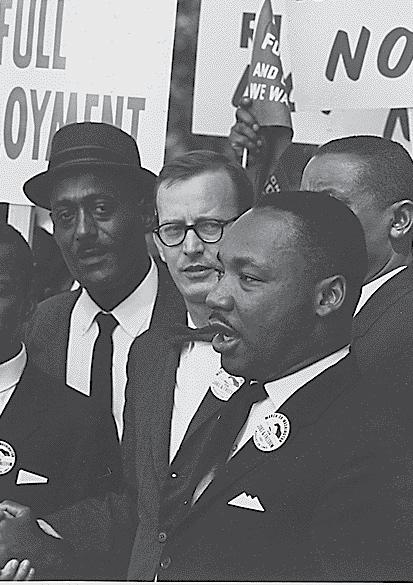
Amid the anguish, some African American musicians for a time abandoned the dream of an integrated art form. Other musicians, despaired at the chaos and turned inward, rejecting musical conventions in search of new forms of personal expression.
It is of course impossible to predict the future, either for jazz or for the United States. But however history unfolds, jazz musicians will be there, mirroring the country’s best traditions and pointing things out when things go wrong.
Spirituality of one sort or another had always been an undercurrent in jazz, but in the 1960s JO HN CO LTRANE, one of the most influential and adventurous saxophonists of the era, put forward the belief that music actually had the power to heal, and he brought an almost religious intensity to everything he played. Coltrane explored the harmonic freedom of modal jazz and the tones and textures of various world musics, and he tested the very limits of his instrument—all in search of a more profound musical meaning. Supported by an equally innovative and turbulent rhythm section, Coltrane developed one of the most powerful and explosive styles in jazz, known as “sheets of sound,” for the torrents of notes that streamed from his horn.
Spiritual though he was, Coltrane was hardly detached from the world around him. In 1963, when he learned that the bombing of an African American church in Birmingham, Alabama, had killed four young girls, he drew on all his expressive resources to create a haunting musical elegy titled simply “Alabama.” This potent combination of seriousness and spirituality became a signature trait of this powerful performer. By 1964, when his landmark album ALoveSupremewas released, Coltrane had already achieved the status of idol among many fans and fellow musicians. “My music,” Coltrane said, “is the spiritual expression of what I am—my faith, my knowledge, my being

Singer, pianist, composer and civil rights activist NINA S IM O N E was born in Tryon, North Carolina in 1933. She learned to play piano at the age of four and sang in her church’s choir while still a child. After finishing high school, Simone won a scholarship to New York City’s Julliard School of Music to train as a classical pianist. She taught piano and worked as an accompanist for other performers while at Julliard, but eventually left school after running out of funds. Turning away from classical music, she started playing American standards, jazz and blues in clubs in the 1950s. Before long, she also started singing along with her music. Simone’s music defied standard genres. Her classical training showed through, no matter what style of song she played, and she drew from many sources including jazz, gospel, pop and folk. By the mid-1960s, Simone became known as a major voice of the Civil Rights Movement. She wrote “Mississippi Goddam” in response to the 1963 assassination of Medgar Evers and the Birmingham church bombing that killed four young African American girls. After the assassination of Reverend Martin Luther King, Jr. in 1968, Simone composed “Why? (The King of Love Is Dead) ” She also wrote “Young, Gifted and Black,” borrowing the title of a play by Lorraine Hansberry, which became a popular anthem of the Civil Rights Era.

Have students write down three definitions of the word "freedom" in preparation for discussing improvisation. They can get the definitions from different sources: dictionaries, poems, song lyrics, family or friends. Have them read their definitions in class and then discuss what freedom means and its relationship to rules in a social setting or in the creation of art, such as dance or painting. Then discuss what freedom can mean when creating music and why it is important.
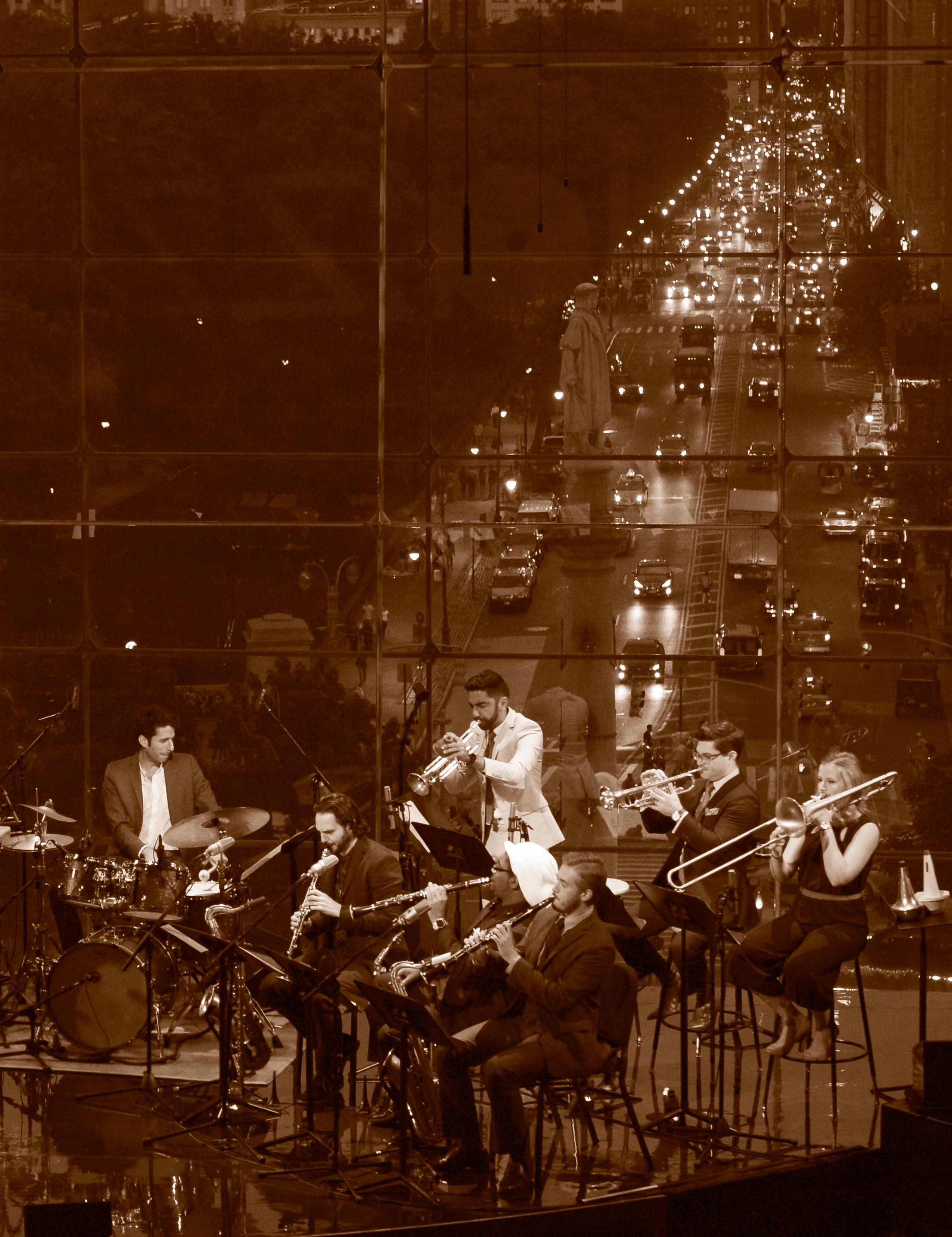
Jazz: A Film by Ken Burns (2000) – A 10-part series featuring interviews with Wynton Marsalis and covering an expansive history of jazz by the acclaimed documentarian of the Civil War, baseball and World War II.
Masters of American Music: The Story of Jazz (1993) – A 98-minute anthology that includes vintage footage and portraits of jazz greats.
Jazz Icons DVD Series – Four series of individual DVDs featuring performances from jazz artists ranging from Thelonious Monk to Nina Simone (more).
The International Sweethearts of Rhythm (VHS only, 1986) – A short documentary about an interracial, all-female jazz ensemble that gained popularity in the 1940s.
The Constitution: That Delicate Balance (Columbia University Seminars on Media and Society, 1984) – Emmy Award-winning series of 13 one-hour videos addressing key Constitutional issues.
Jazz at Lincoln Center jazz.org
Our Courts: 21st Century Civics – An educational website conceived by Justice Sandra Day O’Connor, providing instructional activities for students about the judicial system; includes an additional section on civics. ourcourts.org
National Archives Constitution Site archives.gov/exhibits/charters/constitution.html
National Archives Historical Documents Site archives.gov/historical-docs
National Constitution Center – A wealth of resources on the Constitution, from the Annenberg Center for Outreach and Education. constitutioncenter.org
The Annenberg Foundation Trust at Sunnylands – Includes a wide variety of educational materials from the Sunnylands Constitution Project and special activities for Constitution Day. sunnylandsclassroom.org
NEA Jazz in the Schools – Includes five lesson plans on the history of jazz, with audio links to many accompanying jazz tracks. neajazzintheschools.org
Jazz: A Film by Ken Burns – Companion website to Burns’ 10-part documentary series; includes lesson plans and a wide range of other background materials. pbs.org/jazz
The National Jazz Museum in Harlem – Includes audio tracks and other educational resources. jazzmuseuminharlem.org
New Orleans Jazz National Historic Park (U.S. National Park Service) – Includes background material on important New Orleans jazz artists and the historical importance of New Orleans to the development of jazz. www.nps.gov/jazz
Jazz in America: a resource from the Thelonious Monk Institute of Jazz www.jazzinamerica.org
This abbreviated compilation of recordings aims to serve as an introduction to jazz. It is our hope that the recordings from this list will provide for hours of listening enjoyment and a continued exploration of jazz. The multiple- CD sets listed represent one or more periods of an artist’s career. While they cost more, these collections provide a significantly broader artistic view and are generally a better investment.
Louis Armstrong The Complete Hot Five and Hot Seven Box Set (4- CD set), Columbia/Legacy 63527, 1925–29; Louis Armstrong: The Big Band Recordings (2- CD set), JSP 3 401, 1 930–3 2
Count B asie The Complete Decca Recordings (3- CD set), Decca/GRP Records GRD -3-611, 1 937–39.
Sidney B echet The Best of Sidney Bechet, Blue Note Records CDP 72 43 828891 2 0, 1939–53.
Bix B eiderbecke Riverboat Shuffle, Naxos Jazz 120584, 1924–29.
Art Blakey & The Jazz Messengers Moa nin’, Blue Note Records 95324, 1958.
Ken Burns Jazz : The Story of American Music (5- CD set), Sony/Columbia B 000050 hvg , 2000.
Benny Car ter Further D efinitions, Impulse 220, 1961.
Ornette Coleman The Shape of Jazz to Come, Atlantic Records 1317, 1959.
John Coltrane Coltrane: The Complete 1961 Village Vanguard Recordings (4- CD set), Impulse 4232, 1961; A Love Supreme, Impulse Records GRD 1 55, 1964.
Miles Davis Kind of Blue Columbia Records CK 64935, 1959; The Best of Miles Davis and Gil Evans, Legacy 67425, 1 957–88.
Duke Ellington Ellington at Newport, 1956 (Complete), Columbia 64932; The Blanton-Webster B and (3- CD set), RCA /Bluebird Records 5 659-2- RB 1 940–42.
Bill Evans Portrait in Jazz, Riverside 1162, 1959.
Gil Evans— Miles Ahead (under Miles Davis), Columbia 65339, 1957.
Ella Fitzgerald Ella Fitzgerald: First Lady of Song (3- CD set), Verve Records 314-517 898-2, 1939–41.
Erroll G arner Concert by the Sea, Columbia 40589, 1955.
Dizzy Gillespie The Complete RCA Victor Recordings (2- CD set), RCA Victor/Bluebird (BMG) 66528, 1937–49; Shaw ‘Nuff Musicraft Records MVSCD -53, 1945 –46.
Benny G oodman & Charlie Christian Flying Home, Jazzterdays JTD 1 02410, 1 939–41.
Coleman H awkins Retrospective (2- CD set), RCA Victor/Bluebird (BMG) 66617, 1929–1963.
Fletcher H enderson— Fletcher Henderson a nd t he D ixie Stompers, DRG 8 445, 1 925–1928.
Billie Holiday The Complete Decca Recordings (2- CD set), Decca GRD 601, 1939–44.
Lee Konitz Subconscious-Lee, Prestige 7250, 1949–50.
Scott LaFaro Sunday at the Village Vanguard, Riverside 9376, 1961
Charles Mingus Mingus Ah Um, Columbia Records CBS 65512, 1959.
The Modern Jazz Quartet— Django, Prestige (Fantasy) 7057, 1953–55.
Thelonious Monk The Complete Blue Note Recordings (4- CD set), Blue Note Records CDP 7243 8 30363 2 5, 1947–58.
Jelly Roll Morton Red Hot Peppers, Bluebird / RCA 2361, 1926–30.
King Oliver and His Creole Jazz Band The Complete Set (2- CD set), Retrieval (Allegro), 79007, 1923.
Original Dixieland Jazz Band 75th Anniversary, Bluebird / RCA 61098-4, 1917–1921.
Charlie Parker Jazz at Massey Hall, Debut (Fantasy) 44, 1953; Charlie Parker on Dial Complete (4- CD set), Stateside Records CJ25-5043-6, 1946–47.
Don Redman—1931–1933 , Classics 543.
Sonny Rollins Saxophone Colossus, Prestige Records OJCCD -291-2, 1956.
Wayne Shorter The Best of Wayne Shorter, Blue Note Records CDP 791143 2, 1953–59.
Bessie Smith —The Essential Bessie Smith, Columbia/Legacy 64922, 1923–1933.
The Smithsonian Collection of Classic Jazz—(5- CD set), Sony Music Special Productions B0000048H9, 1995.
Art Tatum The Complete Art Tatum Capital Records (2- CD set), Capital Records 21325, 1949–52.
Lennie Tristano Intuition, Blue Note 52771, 1949–1956.
Frank Trumbauer—see Beiderbecke.
Sarah Vaughan In the Land of Hi-Fi, EmArcy 826454-2, 1955.
Fats Waller The Very Best of Fats Waller, RCA Records 63731.
Mary Lou Williams Zodiac Suite, Smithsonian Folkways 40810, 1945.
Lester Young Lester-Amadeus, Phontastic 7639, 1936/38.
 Myrna Walker Jenny & Jim Jenkins
Myrna Walker Jenny & Jim Jenkins